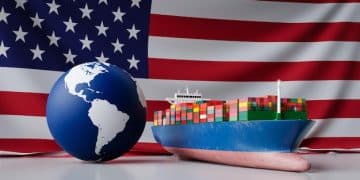US-China Trade Policy: Impact on American Businesses in 2025

The updated US trade policy with China in 2025 is expected to bring both challenges and opportunities for American businesses, influencing their supply chains, market access, and overall competitiveness in the global economy.
The evolving relationship between the US and China continues to be a critical concern for American businesses. How Will the Updated US Trade Policy with China Impact American Businesses in 2025? Understanding the nuances of this policy shift is essential for strategic business planning and ensuring continued success in a complex global market.
Understanding the Evolving US-China Trade Dynamics
The trade relationship between the United States and China is one of the most significant and closely watched aspects of the global economy. Changes in US trade policy towards China can have far-reaching effects on American businesses, influencing everything from import costs to market access.
Keeping abreast of these changes and understanding their potential implications is crucial for businesses looking to navigate this complex landscape. By analyzing the trends and anticipating future policy shifts, businesses can better prepare for the challenges and opportunities that lie ahead.
Key Areas of Trade Policy
Several key areas of trade policy will likely influence the impact on American businesses. These include tariffs, intellectual property rights, and market access.
- Tariffs: Changes in tariff rates can significantly affect the cost of imported goods, impacting supply chains and consumer prices.
- Intellectual Property Rights: Enforcement of intellectual property rights is crucial for protecting American innovation and ensuring fair competition.
- Market Access: The extent to which American businesses can access the Chinese market is a key factor in determining trade benefits.
Understanding these key areas is fundamental to grasping the overall impact of updated trade policies. Businesses must carefully assess how these changes align with their strategic objectives.

Potential Challenges for American Businesses
While updated trade policies may offer some benefits, American businesses may also face significant challenges. Increased costs, regulatory hurdles, and geopolitical uncertainty can all present obstacles to success.
For many businesses, the path forward requires a proactive approach, including diversifying supply chains, seeking new markets, and investing in innovation. Overcoming these challenges will be critical for maintaining competitiveness in the global economy.
Supply Chain Disruptions
One of the primary concerns is the potential for supply chain disruptions. Changes in trade policies can lead to increased uncertainty, making it difficult for businesses to plan and manage their supply chains effectively.
Businesses may need to explore alternative sourcing options, such as nearshoring or reshoring, to mitigate these risks. Building resilience into supply chains is essential for weathering any potential storms.
Increased Costs
Tariffs and other trade barriers can lead to increased costs for American businesses. These costs may be passed on to consumers, potentially impacting demand and profitability.
Businesses should consider strategies to manage these costs, such as negotiating with suppliers, improving efficiency, or seeking government support. Staying competitive in a high-cost environment requires careful planning and execution.
Navigating these challenges requires a strategic approach and a willingness to adapt to changing circumstances. Businesses that can effectively manage these risks will be better positioned for long-term success.
Opportunities Arising from the Updated Trade Policy
Despite the challenges, the updated US trade policy with China may also create opportunities for American businesses. New markets, increased demand for certain goods, and incentives for innovation can all provide avenues for growth.
However, capitalizing on these opportunities requires a proactive approach and a willingness to adapt to changing market conditions. Businesses that can identify and seize these opportunities will be well-positioned for success.

Market Diversification
One of the key opportunities is the potential for market diversification. As trade policies shift, businesses may find new markets to explore, reducing their reliance on China.
- Southeast Asia: Countries like Vietnam, Thailand, and Indonesia offer attractive alternatives for manufacturing and sales.
- India: With a large and growing economy, India presents significant opportunities for American businesses.
- Latin America: The region offers a diverse range of markets with increasing demand for American goods and services.
By diversifying their markets, businesses can reduce their exposure to risk and increase their overall resilience.
Incentives for Innovation
The updated trade policy may also create incentives for innovation. As businesses face new challenges, they may be motivated to develop new products, services, and technologies.
- Research and Development: Investing in R&D can help businesses stay ahead of the competition and create new sources of value.
- Automation: Implementing automation technologies can improve efficiency and reduce costs.
- Sustainability: Developing sustainable products and practices can appeal to environmentally conscious consumers.
Innovation can be a powerful driver of growth, helping businesses adapt to changing conditions and capitalize on new opportunities.
To fully capitalize on these opportunities, American businesses must be proactive and adaptable. By embracing diversification and innovation, they can navigate the changing trade landscape and achieve long-term success.
Strategies for American Businesses to Adapt
To effectively navigate the updated US trade policy with China, American businesses must adopt a range of strategies. These strategies may include diversifying supply chains, investing in technology, and developing strong relationships with key stakeholders.
Businesses that can successfully implement these strategies will be better positioned to weather any challenges and capitalize on emerging opportunities. Adaptation and resilience are key to thriving in a dynamic global economy.
Supply Chain Diversification
Diversifying supply chains is crucial for reducing risk and ensuring business continuity. Businesses should explore alternative sourcing options and build relationships with multiple suppliers.
By spreading their supply chain across different regions and countries, businesses can reduce their vulnerability to disruptions caused by trade policies or geopolitical events. Agility and flexibility are essential in this environment.
Technology Investments
Investing in technology can help businesses improve efficiency, reduce costs, and innovate new products and services. Automation, artificial intelligence, and data analytics can all play a role in enhancing competitiveness.
Businesses should carefully assess their technology needs and invest in solutions that align with their strategic objectives. Technology can be a powerful enabler of growth and adaptation.
Government Support and Resources
Various government agencies and programs can provide support and resources to American businesses navigating international trade. These resources may include export assistance, financing, and market intelligence.
Businesses should explore these resources and leverage them to support their international trade activities. Government support can be a valuable asset in a complex and challenging environment.
Long-Term Implications for the US Economy
The updated US trade policy with China has significant long-term implications for the US economy. These implications may include changes in employment, economic growth, and technological leadership.
Understanding these long-term effects is crucial for policymakers and business leaders alike. By anticipating future trends and challenges, stakeholders can work together to ensure a strong and resilient US economy.
Impact on Employment
Changes in trade policy can impact employment in various sectors. Some industries may experience job losses due to increased competition, while others may see job growth as new opportunities emerge.
- Manufacturing: The impact on manufacturing jobs will depend on the extent to which businesses can reshore or nearshore production.
- Technology: The technology sector may see both job growth and increased competition as businesses innovate new products and services.
- Agriculture: The agricultural sector may be affected by changes in market access and export opportunities.
Understanding these dynamics is essential for developing policies that support job creation and workforce development.
Economic Growth
The updated trade policy can influence overall economic growth. Changes in trade flows, investment, and innovation can all have a significant impact on GDP and productivity.
- Trade Balance: The trade balance between the US and China will be a key indicator of economic performance.
- Investment: Changes in investment flows can impact capital formation and economic growth.
- Productivity: Innovation and technology adoption can drive productivity growth and enhance competitiveness.
A balanced and well-managed trade policy can contribute to sustained economic growth and prosperity.
By understanding these long-term implications, policymakers and business leaders can make informed decisions and develop strategies that promote a strong and resilient US economy.
The Role of Geopolitics in Trade Policy
Geopolitics plays a significant role in shaping trade policy between the US and China. Political tensions, security concerns, and strategic competition can all influence trade relations and impact American businesses.
Businesses operating in this environment must be aware of these geopolitical factors and factor them into their strategic planning. Navigating this complex landscape requires a deep understanding of international relations and political dynamics.
Political Tensions
Political tensions between the US and China can create uncertainty and volatility in trade relations. Disputes over human rights, intellectual property, and territorial claims can all impact business operations.
- Diplomatic Relations: The state of diplomatic relations between the two countries can influence trade negotiations and policy decisions.
- Cybersecurity: Concerns about cybersecurity and espionage can lead to restrictions on technology trade and investment.
- Military Posture: Military tensions in the South China Sea and other regions can impact trade routes and supply chains.
Businesses must monitor these tensions and be prepared to adapt to changing political conditions.
Strategic Competition
The US and China are engaged in strategic competition across various domains, including technology, economics, and military power. This competition can influence trade policy and create both challenges and opportunities for American businesses.
- Technology Race: The race for leadership in key technologies like AI, 5G, and semiconductors can shape trade policy and investment decisions.
- Economic Influence: Both countries are seeking to expand their economic influence globally, including through trade agreements and infrastructure projects.
- Military Modernization: Military modernization efforts can impact security and stability in key regions, affecting trade routes and supply chains.
Businesses must understand these competitive dynamics and develop strategies to maintain their competitive edge. By staying informed and proactive, American businesses can navigate the complexities of the US-China trade relationship and thrive in a dynamic global economy. Maintaining a diversified approach and fostering innovation will be key to long-term success.
| Key Aspect | Brief Description |
|---|---|
| 💼 Trade Policy Impact | Changes in tariffs and trade agreements affect costs and market access. |
| 🔗 Supply Chains | Businesses may need to diversify to reduce dependence on China. |
| 💡 Innovation | Companies can innovate to stay competitive in a changing market. |
| 🌐 Geopolitics | Political tensions can create uncertainty in trade relations. |
Frequently Asked Questions (FAQ)
▼
Tariffs can increase the cost of imported goods, potentially leading to higher prices for consumers and reduced profits for businesses. They may also lead to retaliatory tariffs from other countries.
▼
Businesses can explore alternative sourcing options in countries like Vietnam, India, or Mexico. Building relationships with multiple suppliers can also help reduce risk.
▼
Technology can improve efficiency, reduce costs, and enable businesses to innovate new products and services. Automation and data analytics can also help businesses make better decisions.
▼
Geopolitical tensions and strategic competition can significantly influence trade relations. Political factors can lead to uncertainty and volatility in trade policies, impacting business operations.
▼
Yes, various government agencies and programs offer support and resources to American businesses. These resources may include export assistance, financing, and market intelligence to support international trade activities.
Conclusion
In conclusion, the updated US trade policy with China presents both challenges and opportunities for American businesses in 2025. By understanding the evolving trade dynamics, diversifying markets and supply chains, and leveraging technology and government resources, businesses can navigate this complex landscape and achieve long-term success.





